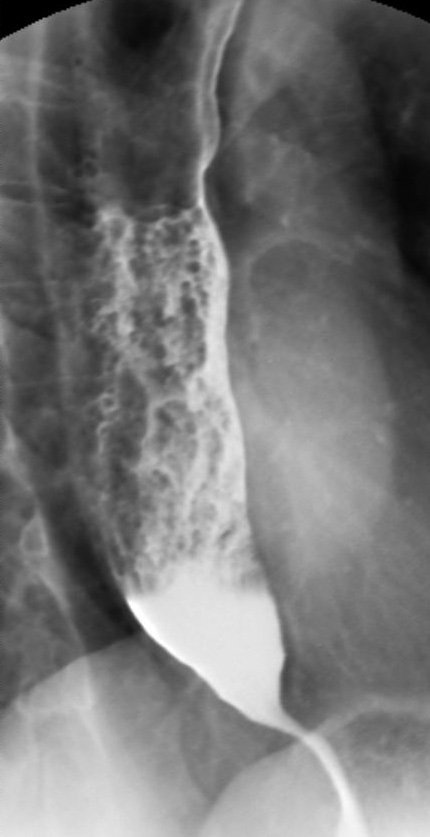WBR0548
Jump to navigation
Jump to search
| Author | [[PageAuthor::Serge Korjian M.D. (Reviewed by Alison Leibowitz) (Reviewed by Serge Korjian)]] |
|---|---|
| Exam Type | ExamType::USMLE Step 1 |
| Main Category | MainCategory::Microbiology |
| Sub Category | SubCategory::Infectious Disease |
| Prompt | [[Prompt::A 33-year-old woman who recently immigrated from Brazil presents for two months of slowly increasing shortness of breath. She reports easy fatigability lately, and several episodes of lower-extremity edema. The patient also complains of two weeks of severe dysphagia and retrosternal chest pain following every meal. She is afraid to eat and has lost approximately 10 pounds. Physical examination reveals jugular venous distension, fine basal crackles, and an S3 gallop. Chest X-ray is unremarkable except for minor congestion. Echocardiography shows a dilated left ventricle with EF of 25%. Barium swallow done to evaluate her dysphagia is shown below. If the patient's disease is infectious in origin, which of the following vectors is most likely responsible? |
| Answer A | AnswerA::Sandfly |
| Answer A Explanation | [[AnswerAExp::Sandfly bites can transmit Leishmania donovani, which causes Kala-azar.]] |
| Answer B | AnswerB::Reduviid Bug |
| Answer B Explanation | [[AnswerBExp::The Reduviid bug is responsible for transmitting Trypanosoma cruzi, the causative agent of Chagas disease.]] |
| Answer C | AnswerC::Ixodes tick |
| Answer C Explanation | [[AnswerCExp::The Ixodes tick transmits babesiosis (Babesia microti) and lyme disease (Borrelia burgdorferi).]] |
| Answer D | AnswerD::Anophelus mosquito |
| Answer D Explanation | [[AnswerDExp::The Anophelus mosquito transmits Plasmodium species, the causative agents of malaria.]] |
| Answer E | AnswerE::Horse fly |
| Answer E Explanation | AnswerEExp::The horse fly can transmit a parasitic filarial worm, known as Loa Loa. |
| Right Answer | RightAnswer::B |
| Explanation | [[Explanation::Chagas disease is caused by the parasite Trypanosoma cruzi. Trypanosoma cruzi is commonly transmitted by "kissing bugs" of the Reduviidae family (Reduviid bugs). Chagas disease is characterized by two stages of illness, acute and chronic. Although the acute stage is frequently asymtomatic, the chronic stage affects the nervous, digestive, and cardiovascular systems. The chronic stage is characterized by dilation of several hollow organs, resulting in megacolon, megaureter, megaesophagus (Chagas disease secondary achalasia with characteristic bird-beak appearance seen on barium swallow), and dilated cardiomyopathy. Treatment of Chagas disease is often with nifurtimox. Chagas disease usually manifests in Central America. Diagnosis of Chagas disease is determined upon serologies and observation of parasite amastigotes on blood smear. Educational Objective: Chagas disease is caused by the parasite Trypanosoma cruzi and is transmitted by Reduviid bugs. |
| Approved | Approved::Yes |
| Keyword | WBRKeyword::Chagas disease, WBRKeyword::Trypanosoma cruzi, WBRKeyword::achalasia, WBRKeyword::dilated cardiomyopathy, WBRKeyword::microbiology, WBRKeyword::transmission, WBRKeyword::spread, WBRKeyword::carrier |
| Linked Question | Linked:: |
| Order in Linked Questions | LinkedOrder:: |
